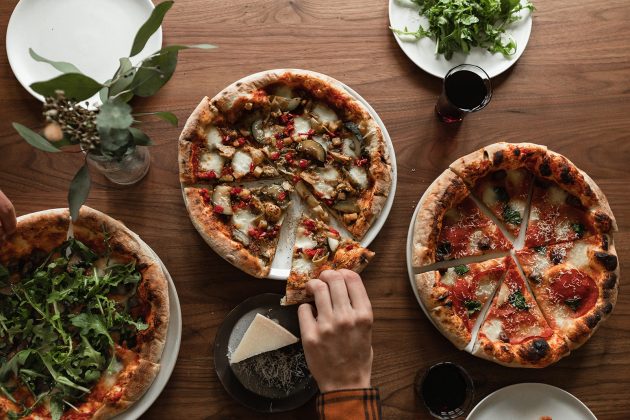
Fresh to frozen: Profile of Holy Napoli Inc.
By By Canadian Pizza Staff
Features Business and Operations Profiles TrendsB.C.’s Holy Napoli takes its signature pizza into the frozen pizza aisle
 Holy Napoli Inc.’s frozen pizzas are available at more than 800 stores across Canada. Photo: Holy Napoli Pizza
Holy Napoli Inc.’s frozen pizzas are available at more than 800 stores across Canada. Photo: Holy Napoli Pizza Holy Napoli Inc. has grown its business from fresh Neapolitan pizza to ready-to-bake frozen pizzas, currently in three traditional flavours, and ready-to-proof pizzas dough balls. We sat down for a Q-and-A with founder Francesca Galasso to learn how the successful business made the transition to compete with “the big guys.”
How did you get started in pizza?
I ran a North Vancouver restaurant, Il Castello, which I started on my own at age 26. We started very much in the retail bricks-and-mortar restaurant scene in 2014. I had gone to the Accademia della Pizza Napoletana in Los Angeles in the summer of 2014. Prior to that I had worked in restaurants in high school and university and did not ever imagine I would open a restaurant. I worked at the University of British Columbia school of nursing and loved what I did, but I had the feeling – some kind of itch – that made me wonder, if not now, when?
One day I strolled by the space and thought, this is it! It was an old building with so much character that used to be a retail chocolate shop. I could see it being perfect, if we put a bit of love into the space. My partner in life and in business, Dave Vukets, and I revamped it a little bit to make it a restaurant. Dave has a background in food science and had an energy bar business. He merged his knowledge of wholesale and manufacturing with my knowledge of pizza. For five years we operated this pizza joint. It was super fun when you’re in your twenties.
We started Holy Napoli in 2017 when we still had the pizzeria. The idea came from our customers, who were asking if they could buy a dough ball.
We took this interesting idea and ran with it. We had connections at this point with local retailers through Dave’s energy bar business. They were the first to take on our proofed pizza dough. It was great, it was catching on. The pizza dough attracts your more foodie-type crowd – families, people who want to make their own pizza but don’t really want to invest the time, effort and process into making a great dough. We took the mess out of the process.

Founder Francesca Galasso earned her chops at the Accademia della Pizza Napoletana in Los Angeles and opened Il Castello in North Vancouver at age 26. Photo: Holy Napoli Pizza
We used our pizzeria as the test clientele. For example, the Calabrese sold really well at the pizzeria. That experience really helped show us what people were really after. There were all these trends emerging: gluten-free, dairy-free, grain-free. People were really in the market for something high quality and not full of preservatives.
Frozen pizza has a bad wrap. But we thought, what if we just made a good pizza and froze it? We wondered, is there an opportunity to innovate in the frozen pizza space. We thought where do our customers shop? The idea was that we won’t compromise on quality and we are willing to spend more to achieve that quality.
How did you go about scaling up your operation?
We wanted to and did start out at a grassroots level with the small, independent retailers. We built up from there, targeting specialty stores. We manufacture all our own products.
In 2019 we sold Il Castello and went heavily into frozen pizza. Good timing as it turns out. People wanted restaurant-quality pizza. With inflation and prices escalating, the question was, can you treat yourself? Is great pizza worth paying more for?
We have a facility in Port Coquitlam where we manufacture our products. We have scaled what we were doing at the restaurant to our pizza dough. It’s a large-scale operation but we’re steadfast on quality. That means using high-quality ingredients and a solid artisanal process.
We currently employ 18 people in production and we run much like any other production facility except we use a stone oven. That is super key for that initial oven spring in the crust.
We think of time as an ingredient. Time is a very limited resource. Everyone wants to cut it out of the equation, but in baking it’s an integral part of the process. There are some things you can do to speed up process but there are no shortcuts.
We think of time as an ingredient. There are some things you can do to speed up process but there are no shortcuts.
How difficult was it getting started?
The Women’s Enterprise Centre helped us with a start-up loan in connection with Futurpreneur Canada, a national non-profit organization that helps entrepreneurs – by providing mentorship, loans and business practice assistance. We also had help from Women’s Enterprise Canada, which supports women entrepreneurs. They provided a loan that comes with mentorship and guidance.
I feel so fortunate. We had so much help from these organizations. Manufacturing is very capital-intensive – you need equipment and overhead costs are high. It’s a very different type of business from retail with a different cash flow.
As we moved along and progressed, the business grew into grocery stores in other provinces. We eventually made our way to Ontario and Quebec. We then partnered with Business Development Bank of Canada, who provided a loan. Eventually we linked up with Bond Bakery Brands in 2021. Now we have pizza in about 300 Loblaw stores. We’re right across the country, even to the Maritimes, which is amazing. We’re excited we can say we’re coast to coast!
As of October we’re available at over 800 stores in Canada, including premium grocers like Georgia Main Food Group, Whole Foods Market, Thrifty Foods, Pattison Food Group, Calgary Coop, as well as larger chains Loblaws, Atlantic Superstores and Metro.
How would you describe your signature pizza?
No two pizzas are the same. We hand-stretch our dough to make the cornicione, that raised outer edge of the crust. It’s baked in a stone oven at 800 F so it’s light, chewy and charred just right for the perfect crunch. We do a minimum 24-hour fermentation.
What a lot of people appreciate is that you can tell the pizzas are quite visibly handmade. They don’t all look identical and we kind of like it that way.
Can you share any sales numbers or milestones?
One way to measure our growth is by the store count. We’ve been able to go national with an upstart pizza brand. You’re going up against the big guys. It’s a real testament to the quality of product we can put out at scale. Grocery buyers are making the decision to purchase our product – that’s a big deal.
We’re certainly on the higher end of the price scale but a lot of people would compare our pizzas to Amy’s Kitchen in the $12.49-12.99 range imported from the U.S. We’re not that high. The frozen pizza side is so interesting because it exists on a continuum. If you’re in the market for a $2.99 pizza, you can find it. If you’re in the market for a gourmet pizza, you can find it. There’s everything in between. Then you have your vegan, grain-free, gluten-free pizzas. We’ve positioned ourselves in that market. It’s a matter of what resonates with the consumer – what do they care about?
How big a concern is sustainability?
We are constantly looking at what packaging is becoming mainstream and commercially available. Our pizzas are packaged in shrink film. We’re looking at new materials all the time.
We always run into the question of what is commercially compostable and what is not. Even with flexible packaging – for example, our dough packages are recyclable if your municipality recycles it. Every city is a little bit different. There’s no universal solution – it’s finding ways to get a little bit better all the time.
Thinking back on starting out, what might you do differently? What advice would you have for others, specifically other independent pizzerias looking at entering the retail frozen aisle?
I would say to really be aware of your costs and be open to what your cost of goods actually is when you start to consider what it costs to ship across the country. Scaling a product is expensive. Some people may want to sell from their store and that’s as big as they get. Independent pizzerias may want to start with a local retailer. As you get larger there are regulatory considerations. Turning it into a consumer packaged goods product is a very different thing – margins are different, costs look very different. You can never be too honest with yourself about what your cost of goods captures and what is required to get your product on a grocery store shelf.
My partner Dave is very operations focused and has such a keen eye for detail and everything that goes into the manufacturing process. How do you make 1,000 pizzas, freeze them and sell them? I’m more on the creative side working on product development. He asks how do we execute that? He has a great understanding and appreciation for what goes into the product and a strong food safety and food science background. As you grow, you’re looking for more certifications such as HACCP. When you operate a restaurant, you have to plan for the inspector checks, but at a larger scale you’re undergoing a food safety audit.
There are lots of opportunities out there. It’s a matter of what direction we choose. Where can we be proactive? Where can we improve and refine? Maybe it’s an opportunity to come up with five different flavours. It’s exciting. I don’t think people are going to stop seeking out quality products at a reasonable price. It’s going to be a matter of tuning into what our customers want and where do they want to find it.
Print this page